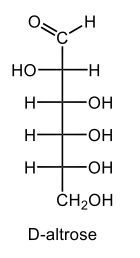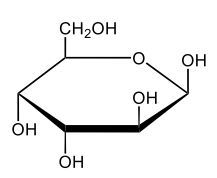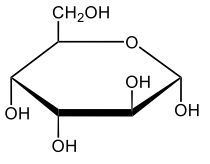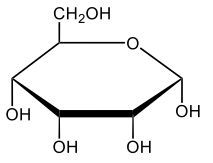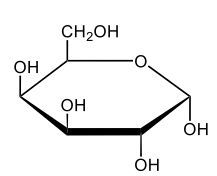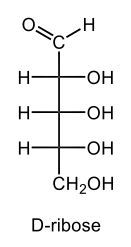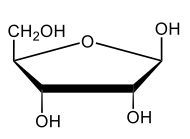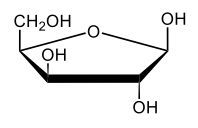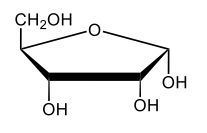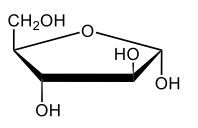Here we're going to say that monosaccharides exist as cyclic hemiacetals in aqueous solutions. Now cyclization takes place when the penultimate alcohol reacts with the C1 aldehyde group. If we take a look here in the center, we have the acyclic monosaccharide in the form of D-glucose. And we're talking about the penultimate alcohol, so we're talking about this alcohol here. This alcohol is what's going to help to make this within our structure. Now from this acyclic form, we're able to create two possibilities. One where the OH is pointed down when it comes to this hemiacetyl carbon, and one where it's pointing up. But how do we know what they are called? Well, this is where the term anomers comes into play. Anomers, these are just epimers produced by cyclization of monosaccharides. Remember, an epimer means that we have the same configuration at all chiral centers except for one place. If we were to look, all the chiral centers are the same everywhere except for carbon number 1, because that OH could either point down or point up. That gives us 2 epimers or anomers of each other. Here we're gonna say alpha anomer. This is where the OH group and the CH2OH group are on opposite sides of each other. If we can see, the OH group is pointed down here, but the CH2OH group is pointed up. They're opposites of each other, so this would be alpha D-glucose. And then beta anomer, this is where our anomeric OH and C6 CH2OH are on the same side. This will be beta. Now, remember carbon number 1, we can call it the hemiacetyl carbon, but we can also call it the anomeric carbon because it can give us 2 possibilities. The OH could orient itself down, giving us alpha, or could orient itself up, giving us beta. These would be epimers or anomers of each other. Alright. So just remember, we're going from the noncyclic form of glucose, and once we put it in an aqueous environment, it's gonna coil up to form either this ring or this ring as its dominant forms. So keep that in mind when we're talking about different types of cyclic hemiacetals that originate from an acyclic monosaccharide.
- 1. Matter and Measurements4h 29m
- What is Chemistry?5m
- The Scientific Method9m
- Classification of Matter16m
- States of Matter8m
- Physical & Chemical Changes19m
- Chemical Properties8m
- Physical Properties5m
- Intensive vs. Extensive Properties13m
- Temperature (Simplified)9m
- Scientific Notation13m
- SI Units (Simplified)5m
- Metric Prefixes24m
- Significant Figures (Simplified)11m
- Significant Figures: Precision in Measurements7m
- Significant Figures: In Calculations19m
- Conversion Factors (Simplified)15m
- Dimensional Analysis22m
- Density12m
- Specific Gravity9m
- Density of Geometric Objects19m
- Density of Non-Geometric Objects9m
- 2. Atoms and the Periodic Table5h 23m
- The Atom (Simplified)9m
- Subatomic Particles (Simplified)12m
- Isotopes17m
- Ions (Simplified)22m
- Atomic Mass (Simplified)17m
- Atomic Mass (Conceptual)12m
- Periodic Table: Element Symbols6m
- Periodic Table: Classifications11m
- Periodic Table: Group Names8m
- Periodic Table: Representative Elements & Transition Metals7m
- Periodic Table: Elemental Forms (Simplified)6m
- Periodic Table: Phases (Simplified)8m
- Law of Definite Proportions9m
- Atomic Theory9m
- Rutherford Gold Foil Experiment9m
- Wavelength and Frequency (Simplified)5m
- Electromagnetic Spectrum (Simplified)11m
- Bohr Model (Simplified)9m
- Emission Spectrum (Simplified)3m
- Electronic Structure4m
- Electronic Structure: Shells5m
- Electronic Structure: Subshells4m
- Electronic Structure: Orbitals11m
- Electronic Structure: Electron Spin3m
- Electronic Structure: Number of Electrons4m
- The Electron Configuration (Simplified)22m
- Electron Arrangements5m
- The Electron Configuration: Condensed4m
- The Electron Configuration: Exceptions (Simplified)12m
- Ions and the Octet Rule9m
- Ions and the Octet Rule (Simplified)8m
- Valence Electrons of Elements (Simplified)5m
- Lewis Dot Symbols (Simplified)7m
- Periodic Trend: Metallic Character4m
- Periodic Trend: Atomic Radius (Simplified)7m
- 3. Ionic Compounds2h 18m
- Periodic Table: Main Group Element Charges12m
- Periodic Table: Transition Metal Charges6m
- Periodic Trend: Ionic Radius (Simplified)5m
- Periodic Trend: Ranking Ionic Radii8m
- Periodic Trend: Ionization Energy (Simplified)9m
- Periodic Trend: Electron Affinity (Simplified)8m
- Ionic Bonding6m
- Naming Monoatomic Cations6m
- Naming Monoatomic Anions5m
- Polyatomic Ions25m
- Naming Ionic Compounds11m
- Writing Formula Units of Ionic Compounds7m
- Naming Ionic Hydrates6m
- Naming Acids18m
- 4. Molecular Compounds2h 18m
- Covalent Bonds6m
- Naming Binary Molecular Compounds6m
- Molecular Models4m
- Bonding Preferences6m
- Lewis Dot Structures: Neutral Compounds (Simplified)8m
- Multiple Bonds4m
- Multiple Bonds (Simplified)6m
- Lewis Dot Structures: Multiple Bonds10m
- Lewis Dot Structures: Ions (Simplified)8m
- Lewis Dot Structures: Exceptions (Simplified)12m
- Resonance Structures (Simplified)5m
- Valence Shell Electron Pair Repulsion Theory (Simplified)4m
- Electron Geometry (Simplified)8m
- Molecular Geometry (Simplified)11m
- Bond Angles (Simplified)11m
- Dipole Moment (Simplified)15m
- Molecular Polarity (Simplified)7m
- 5. Classification & Balancing of Chemical Reactions3h 17m
- Chemical Reaction: Chemical Change5m
- Law of Conservation of Mass5m
- Balancing Chemical Equations (Simplified)13m
- Solubility Rules16m
- Molecular Equations18m
- Types of Chemical Reactions12m
- Complete Ionic Equations18m
- Calculate Oxidation Numbers15m
- Redox Reactions17m
- Spontaneous Redox Reactions8m
- Balancing Redox Reactions: Acidic Solutions17m
- Balancing Redox Reactions: Basic Solutions17m
- Balancing Redox Reactions (Simplified)13m
- Galvanic Cell (Simplified)16m
- 6. Chemical Reactions & Quantities2h 35m
- 7. Energy, Rate and Equilibrium3h 46m
- Nature of Energy6m
- First Law of Thermodynamics7m
- Endothermic & Exothermic Reactions7m
- Bond Energy14m
- Thermochemical Equations12m
- Heat Capacity19m
- Thermal Equilibrium (Simplified)8m
- Hess's Law23m
- Rate of Reaction11m
- Energy Diagrams12m
- Chemical Equilibrium7m
- The Equilibrium Constant14m
- Le Chatelier's Principle23m
- Solubility Product Constant (Ksp)17m
- Spontaneous Reaction10m
- Entropy (Simplified)9m
- Gibbs Free Energy (Simplified)18m
- 8. Gases, Liquids and Solids3h 25m
- Pressure Units6m
- Kinetic Molecular Theory14m
- The Ideal Gas Law18m
- The Ideal Gas Law Derivations13m
- The Ideal Gas Law Applications6m
- Chemistry Gas Laws16m
- Chemistry Gas Laws: Combined Gas Law12m
- Standard Temperature and Pressure14m
- Dalton's Law: Partial Pressure (Simplified)13m
- Gas Stoichiometry18m
- Intermolecular Forces (Simplified)19m
- Intermolecular Forces and Physical Properties11m
- Atomic, Ionic and Molecular Solids10m
- Heating and Cooling Curves30m
- 9. Solutions4h 10m
- Solutions6m
- Solubility and Intermolecular Forces18m
- Solutions: Mass Percent6m
- Percent Concentrations10m
- Molarity18m
- Osmolarity15m
- Parts per Million (ppm)13m
- Solubility: Temperature Effect8m
- Intro to Henry's Law4m
- Henry's Law Calculations12m
- Dilutions12m
- Solution Stoichiometry14m
- Electrolytes (Simplified)13m
- Equivalents11m
- Molality15m
- The Colligative Properties15m
- Boiling Point Elevation16m
- Freezing Point Depression9m
- Osmosis16m
- Osmotic Pressure9m
- 10. Acids and Bases3h 29m
- Acid-Base Introduction11m
- Arrhenius Acid and Base6m
- Bronsted Lowry Acid and Base18m
- Acid and Base Strength17m
- Ka and Kb12m
- The pH Scale19m
- Auto-Ionization9m
- pH of Strong Acids and Bases9m
- Acid-Base Equivalents14m
- Acid-Base Reactions7m
- Gas Evolution Equations (Simplified)6m
- Ionic Salts (Simplified)23m
- Buffers25m
- Henderson-Hasselbalch Equation16m
- Strong Acid Strong Base Titrations (Simplified)10m
- 11. Nuclear Chemistry56m
- BONUS: Lab Techniques and Procedures1h 38m
- BONUS: Mathematical Operations and Functions47m
- 12. Introduction to Organic Chemistry1h 34m
- 13. Alkenes, Alkynes, and Aromatic Compounds2h 12m
- 14. Compounds with Oxygen or Sulfur1h 6m
- 15. Aldehydes and Ketones1h 1m
- 16. Carboxylic Acids and Their Derivatives1h 11m
- 17. Amines38m
- 18. Amino Acids and Proteins1h 51m
- 19. Enzymes1h 37m
- 20. Carbohydrates1h 46m
- Intro to Carbohydrates4m
- Classification of Carbohydrates4m
- Fischer Projections4m
- Enantiomers vs Diastereomers8m
- D vs L Enantiomers8m
- Cyclic Hemiacetals8m
- Intro to Haworth Projections4m
- Cyclic Structures of Monosaccharides11m
- Mutarotation4m
- Reduction of Monosaccharides10m
- Oxidation of Monosaccharides7m
- Glycosidic Linkage14m
- Disaccharides7m
- Polysaccharides7m
- 21. The Generation of Biochemical Energy2h 8m
- 22. Carbohydrate Metabolism2h 22m
- 23. Lipids2h 26m
- Intro to Lipids6m
- Fatty Acids25m
- Physical Properties of Fatty Acids6m
- Waxes4m
- Triacylglycerols12m
- Triacylglycerol Reactions: Hydrogenation8m
- Triacylglycerol Reactions: Hydrolysis13m
- Triacylglycerol Reactions: Oxidation7m
- Glycerophospholipids15m
- Sphingomyelins13m
- Steroids15m
- Cell Membranes7m
- Membrane Transport10m
- 24. Lipid Metabolism1h 45m
- 25. Protein and Amino Acid Metabolism1h 37m
- 26. Nucleic Acids and Protein Synthesis2h 54m
- Intro to Nucleic Acids4m
- Nitrogenous Bases16m
- Nucleoside and Nucleotide Formation9m
- Naming Nucleosides and Nucleotides13m
- Phosphodiester Bond Formation7m
- Primary Structure of Nucleic Acids11m
- Base Pairing10m
- DNA Double Helix6m
- Intro to DNA Replication20m
- Steps of DNA Replication11m
- Types of RNA10m
- Overview of Protein Synthesis4m
- Transcription: mRNA Synthesis9m
- Processing of pre-mRNA5m
- The Genetic Code6m
- Introduction to Translation7m
- Translation: Protein Synthesis18m
Cyclic Structures of Monosaccharides - Online Tutor, Practice Problems & Exam Prep
 Created using AI
Created using AIMonosaccharides, such as d-glucose, exist as cyclic hemiacetals in aqueous solutions through cyclization, where the penultimate alcohol reacts with the aldehyde group. This process creates two anomers: alpha and beta, distinguished by the orientation of the hydroxyl group at the anomeric carbon (carbon 1). In the alpha form, the hydroxyl group is down, while in the beta form, it is up. Understanding these configurations is crucial for studying carbohydrates and their biochemical roles, including their participation in metabolic pathways like glycolysis and glycogenesis.
Cyclic Structures of Monosaccharides Concept 1
Video transcript
Cyclic Structures of Monosaccharides Example 1
Video transcript
Here it says draw on Haworth projection for beta-D-galactose. Alright. So step 1 is we're going to number the Fischer projection. So 1, 2, 3, 4, 5, and 6. And rotate it clockwise to turn it on its side. So now it's 123456. Notice that we're starting out with D-galactose. We don't get beta until it's in its cyclic form. Step 2 now is we're going to curl the CH2OH group clockwise, keeping the carbonyl group in the far right corner. So here we're gonna kind of like bend this structure, it's linear right now, we're gonna bend it a little bit, curve upon itself, so that my CH2OH group and my carbonyl group are in similar positions, similar area with each other. Now, this is gonna be a little bit tricky. We're going to rotate C5, so carbon number 5 here. So, CH2OH faces up, bringing OH group close to the carbonyl group. Alright. So basically, we're gonna have this OH and this CH2OH moving. So this COH is gonna move to where CH2OH is, and then C5H2OH is gonna move here. So that we get now, CH2OH up here, and then the OH rotated over here. And here, we're gonna close the ring to form the cyclic hemiacetal and assign alpha or beta to the anomeric OH group. Remember, the anomeric group is carbon number 1. It is the carbon that was the carbonyl group here. Alright. So basically, this OH and this Carbon are gonna form a bond with each other, this bond here. Oxygen ideally wants to only make 2 bonds, so it's gonna lose its H. And we're gonna say that this double bonded O is no longer gonna be double bonded because carbon can't make 5 bonds. It's gonna transform into an OH group. We said here beta, which means that the OH group has to be on the same side as a CH2OH group. So OH would be up here, oriented up here. And this H is still around and it'd have to be down here. So this here will represent our beta-D-galactose structure.
Draw a Haworth projection for α-D-altrose.
D-ribose is an aldopentose sugar that is found in the DNA. It commonly exists as a five-membered β anomer. Draw D‑ribose in its cyclic hemiacetal form.
Do you want more practice?
Here’s what students ask on this topic:
What are the cyclic structures of monosaccharides?
Monosaccharides, such as d-glucose, can form cyclic structures known as hemiacetals in aqueous solutions. This cyclization occurs when the penultimate alcohol group reacts with the aldehyde group, forming a ring structure. The most common cyclic forms are five-membered (furanose) and six-membered (pyranose) rings. For example, d-glucose typically forms a six-membered ring. The cyclization creates two anomers: alpha and beta, which differ in the orientation of the hydroxyl group at the anomeric carbon (carbon 1). In the alpha anomer, the hydroxyl group is down, while in the beta anomer, it is up.
 Created using AI
Created using AIHow do alpha and beta anomers of glucose differ?
Alpha and beta anomers of glucose differ in the orientation of the hydroxyl group at the anomeric carbon (carbon 1). In the alpha anomer, the hydroxyl group is positioned down relative to the plane of the ring, while in the beta anomer, it is positioned up. This difference in orientation occurs during the cyclization of the linear form of glucose into its cyclic form. These anomers are a type of epimer, meaning they have the same configuration at all chiral centers except for the anomeric carbon.
 Created using AI
Created using AIWhat is the significance of the anomeric carbon in monosaccharides?
The anomeric carbon in monosaccharides is significant because it is the carbon that becomes a new chiral center during the cyclization process. In glucose, this is carbon 1. The orientation of the hydroxyl group attached to the anomeric carbon determines whether the sugar is in the alpha or beta form. This distinction is crucial for the sugar's biochemical properties and its role in metabolic pathways. The anomeric carbon is also the site of glycosidic bond formation when monosaccharides link to form disaccharides and polysaccharides.
 Created using AI
Created using AIHow does cyclization of monosaccharides occur?
Cyclization of monosaccharides occurs when the penultimate alcohol group (the hydroxyl group on the second-to-last carbon) reacts with the aldehyde or ketone group. In the case of glucose, the hydroxyl group on carbon 5 reacts with the aldehyde group on carbon 1, forming a hemiacetal. This reaction creates a ring structure, typically a six-membered ring (pyranose) for glucose. The cyclization can result in two different anomers, alpha and beta, depending on the orientation of the hydroxyl group at the anomeric carbon.
 Created using AI
Created using AIWhat role do cyclic structures of monosaccharides play in metabolism?
Cyclic structures of monosaccharides play a crucial role in metabolism. For instance, glucose in its cyclic form is a key substrate in glycolysis, where it is broken down to produce energy. The cyclic form also participates in glycogenesis, where glucose molecules are polymerized to form glycogen for energy storage. The specific anomeric form (alpha or beta) can influence the enzyme interactions and the efficiency of these metabolic pathways. Understanding these cyclic structures is essential for studying carbohydrate metabolism and energy production in cells.
 Created using AI
Created using AIYour GOB Chemistry tutor
- In the monosaccharide hemiacetal shown below number all the carbon atoms, identify the anomeric carbon atom, a...
- The cyclic structure of d-idose, an aldohexose, is shown in the margin. Convert this to the straight-chain Fis...
- Identify the following as diastereomers, enantiomers, and/or anomers. (a) ß-d-fructose and ß-d-fructose (b) d-...
- d-Talose, a constituent of certain antibiotics, has the open-chain structure shown next. Draw d-talose in its ...
- l-Fucose is one of the naturally occurring l monosaccharides. It is present in the short chains of monosacchar...
- Draw the structure of the α and ß anomers that result from the reaction of methanol and ribose. Are these comp...
- In its open-chain form, d-mannose, an aldohexose found in orange peels, has the structure shown here. Coil man...
- d-Fructose can form a six-membered cyclic hemiacetal as well as the more prevalent five-membered cyclic form. ...
- What are the kind and number of atoms in the ring portion of the Haworth structure of glucose?
- Draw the Haworth structures for α- and ß-D-glucose.
- Identify each of the following as the α or ß isomer:a. <IMAGE>
- The sugar d-gulose is a sweet-tasting syrup. (13.3, 13.4)<IMAGE>b. Draw the Haworth structures for α− an...
- Identify the following carbohydrates as the α or ß anomer: (b) <IMAGE>
- Identify the following carbohydrates as the α or ß anomer:(a) <IMAGE>
- Identify the following carbohydrates as the α or ß anomer:(a) <IMAGE>
